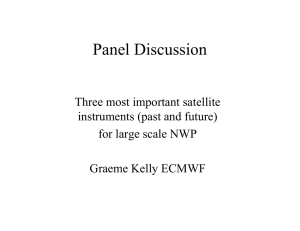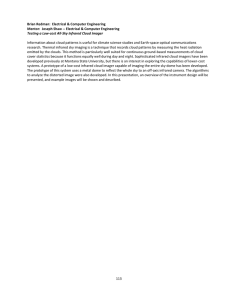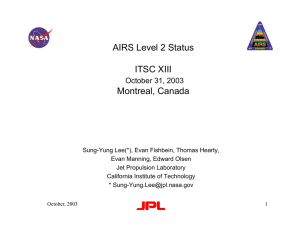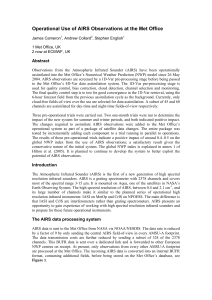Assimilation of data from AIRS for improved numerical weather prediction.
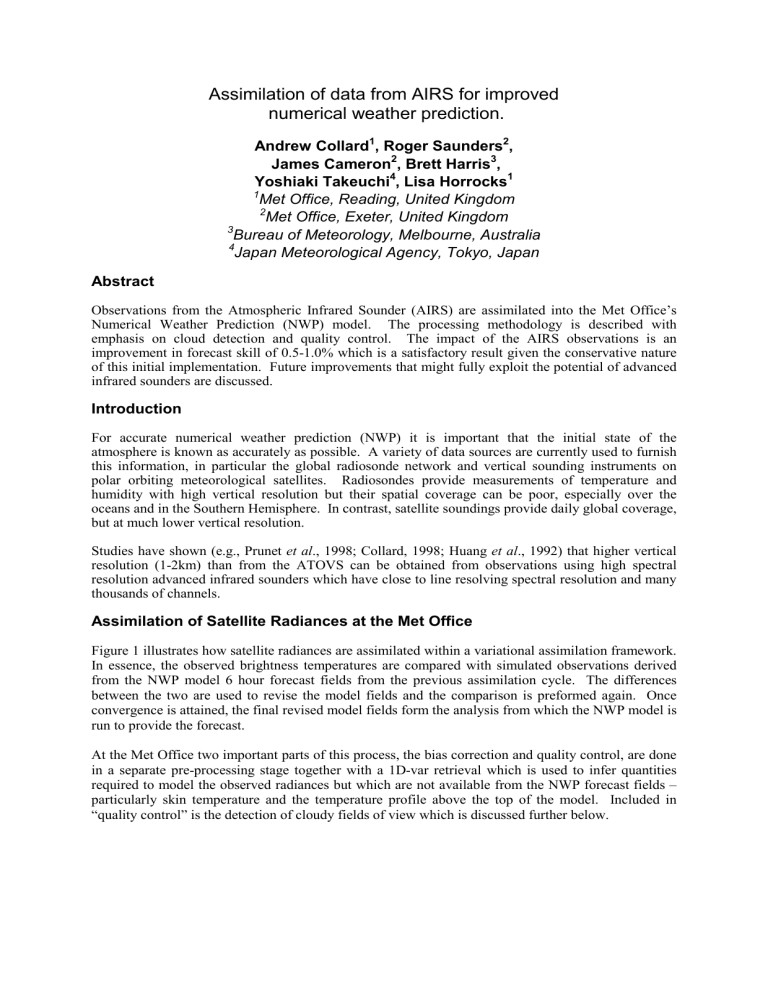
Assimilation of data from AIRS for improved
numerical weather prediction.
Andrew Collard
1
, Roger Saunders
2
,
James Cameron
2
, Brett Harris
3
,
Yoshiaki Takeuchi
4
, Lisa Horrocks
1
1
Met Office, Reading, United Kingdom
2
Met Office, Exeter, United Kingdom
3
Bureau of Meteorology, Melbourne, Australia
4
Japan Meteorological Agency, Tokyo, Japan
Abstract
Observations from the Atmospheric Infrared Sounder (AIRS) are assimilated into the Met Office’s
Numerical Weather Prediction (NWP) model. The processing methodology is described with emphasis on cloud detection and quality control. The impact of the AIRS observations is an improvement in forecast skill of 0.5-1.0% which is a satisfactory result given the conservative nature of this initial implementation. Future improvements that might fully exploit the potential of advanced infrared sounders are discussed.
Introduction
For accurate numerical weather prediction (NWP) it is important that the initial state of the atmosphere is known as accurately as possible. A variety of data sources are currently used to furnish this information, in particular the global radiosonde network and vertical sounding instruments on polar orbiting meteorological satellites. Radiosondes provide measurements of temperature and humidity with high vertical resolution but their spatial coverage can be poor, especially over the oceans and in the Southern Hemisphere. In contrast, satellite soundings provide daily global coverage, but at much lower vertical resolution.
Studies have shown (e.g., Prunet et al., 1998; Collard, 1998; Huang et al., 1992) that higher vertical resolution (1-2km) than from the ATOVS can be obtained from observations using high spectral resolution advanced infrared sounders which have close to line resolving spectral resolution and many thousands of channels.
Assimilation of Satellite Radiances at the Met Office
Figure 1 illustrates how satellite radiances are assimilated within a variational assimilation framework.
In essence, the observed brightness temperatures are compared with simulated observations derived from the NWP model 6 hour forecast fields from the previous assimilation cycle. The differences between the two are used to revise the model fields and the comparison is preformed again. Once convergence is attained, the final revised model fields form the analysis from which the NWP model is run to provide the forecast.
At the Met Office two important parts of this process, the bias correction and quality control, are done in a separate pre-processing stage together with a 1D-var retrieval which is used to infer quantities required to model the observed radiances but which are not available from the NWP forecast fields – particularly skin temperature and the temperature profile above the top of the model. Included in
“quality control” is the detection of cloudy fields of view which is discussed further below.
Fig. 1: Schematic illustrating the assimilation of Satellite Radiances.
AIRS Data and Channel Selection
The Atmospheric Infrared Sounder (AIRS) is the first in a new generation of advanced infrared sounders to be launched in the first few years of the 21 st
century. Although it is an experimental instrument (flying on the EOS-PM – renamed Aqua – satellite), its similarity to future advanced infrared sounders (IASI on MetOp and CrIS on NPOESS) makes it ideal for preparing the operational numerical weather prediction centres for these new instruments.
AIRS is a grating spectrometer with 2378 channels at approximately 1cm
-1
resolution covering the 3-
15
µ m spectral interval (although this coverage is not continuous). It therefore differs from all future advanced infrared sounders which will all be interferometers.
AIRS data are sent to the operational NWP centres from NASA via NOAA/NESDIS (thanks to the efforts of M. Goldberg and W. Wolf). At NOAA/NESDIS the data volume is reduced by around two orders of magnitude, primarily for data transmission reasons. This reduction is done two ways.
Firstly, only one in every eighteen fields of view are used – corresponding to the central AIRS field of view in every other co-located AMSU-A field of view. Secondly, a subset of 324 channels are sent that were chosen at NASA/GSFC (Susskind et al., 2003) such that retrievals could be made that could then be used to reconstruct the observed radiances to within the instrumental noise (around 50 of these channels were added later to help with CO
2
retrieval work).
All 324 channels are routinely monitored
(see http://www.metoffice.com/research/nwp/satellite/infrared/sounders/airs/index.html), except for channel 2357 which has been very noisy. In addition all 15 AMSU-A channels from the co-located field of view are also monitored.
After exclusion of those channels that are sensitive to ozone (which we are not considering) and some of the higher peaking CO
2
channels (which not only primarily provide information above the top of our NWP model but some of which require the consideration of non-LTE effects to correctly model
the observations), the total number of channels is further reduced by consideration of the information content (degrees of freedom for signal) for a variety of atmospheres following the method of Rodgers
(1996). For assimilation purposes, we therefore consider 71 channels during the day and 86 at night; the difference being due to solar contamination in the shortwave channels during the day that we cannot currently deal with in our radiative transfer models (some extra long wave channels are employed in the daytime though). It is anticipated that more channels may be used in the future once the impact of AIRS is confirmed and the available resources on our new computer (an NEC-SX6) running our new assimilation system (the Met Office will move to 4 Dimensional Variational
Assimilation – 4D-var – from 3D-var in 2004) become clear.
Figure 2 shows a typical AIRS spectrum with the 324 channels distributed by NOAA/NESDIS indicated. Also shown are the channels used for assimilation and the channels used in cloud detection
(see below).
Fig. 2: AIRS Channel selection. The black points are all the AIRS channels, the 324 channels distributed by NOAA/NESDIS are indicated by the red crosses at the bottom. The cyan, red and green stars indicate the channels used for assimilation during the day, night and at all times respectively. Cloud detection channels are indicated by the blue crosses.
Cloud detection and Quality Control
Initial quality control of the observations includes gross checks for reasonable values in all channels that will be used in the later processing. The atmospheric profiles corresponding to the observations are also checked to ensure that they are within the range of acceptable values for the RTTOV radiative transfer model. Bias correction is applied (Harris et al., 2004) before the cloud detection stage.
A strategy for the treatment of cloud is essential for the treatment of any infrared system that probes the troposphere. Here we take the conservative approach of only considering those observations where there is no cloud in the field of view. The cloud detection scheme uses the variational cloud detection method of English et al. (1999). This method calculates a cost function which is related to the probability of the field of view being clear given the observations and the calculated clear radiances based on the 6-hour forecast background profiles.
For AIRS, ten channels are used which are distributed through the longwave window region and the
15
µ m CO
2
band, plus AMSU-A Channel 3 which is the lowest peaking AMSU-A channel for which surface emissivity uncertainties are not a problem for this purpose. The AMSU-A channel is particularly useful as, compared to infrared measurements, it is relatively insensitive to clouds and therefore any inconsistencies between this channel and the infrared channels can be interpreted as an indicator of cloud contamination in the infrared field of view.
Figure 3 shows how the cloud cost function varies with a longwave window channel’s observedbackground (O-B) difference. The O-B in the window channel is often a strong indicator of a cloud in the field of view, as illustrated by the inset in the figure which shows the full range of observations.
Fig. 3: AIRS Cloud Cost versus the difference between the observed brightness temperatures and those calculated using the model 6hour forecast data for a longwave window channel. Those points where
O-B
< 2K and the cloud cost < 0.4 are considered clear.
The main panel of this figure shows the cloud costs for cases where any cloud has an impact of only a few Kelvin on the observed brightness temperatures. In this case one can see that there is a clustering of points where the longwave O-B difference is less than 2K and the cloud cost function is less than
0.4K. When one considers the symmetry of the plot and remembers that clouds rarely cause O-B to be positive, it seems reasonable to assume that these points will correspond to observations that may be considered clear.
At this stage, the O-B differences are checked for all channels that are to be used to ensure they lie in the
±
20K range, i.e., that there are no channels with gross error when observations and background are compared.
As mentioned above, part of the pre-processing before the observations are presented for assimilation is a 1D-var retrieval in order to determine the temperature profile in the stratosphere and the surface skin temperature neither of which are available from the model in the full assimilation stage. A byproduct of this process is that the 1D-var retrieval serves as a final quality control; if the minimisation at the 1D-var does not converge or converges with a high cost function value, the observation may also be problematic at the 3D-var stage and is best rejected (at least in this initial, conservative implementation).
Figure 4 shows a histogram of the final cost functions after the 1D-var minimisation. Theory states that the expected mean value of the cost function (which here is normalised by the number of channels) is 0.5 with a standard deviation of 1/
√
(2×[Number of Channels]), when all errors are known and Gaussian and the problem is linear. With these caveats, the fact that the 1D-var cost function has a distribution similar to that which theory predicts is very encouraging, as the assumed background, observational and forward model errors are all likely to be different to reality.
Fig. 4: Histogram of final 1D-var retrieval cost. The dotted line indicates the theoretical curve given perfect knowledge of observational, forward model and background error covariances and a linear problem. Given the uncertainties in these errors, the distribution of 1D-var costs is very encouraging. Also shown is the cut-off employed so as to not assimilate those observations which caused problems in the 1D-var minimisation step (not shown are around ten cases where the cost function is between 1 and 4).
When the 1D-var final cost function is large, this is an indication that the 6 hour forecast and the observations differ significantly. This may be due to a real difference between the forecast and reality,
but it is more likely that there are errors in the observations that preclude closer convergence. Cloud contamination that was missed by the cloud detection scheme is one possibility. Observations with final 1D-var cost function values greater than 0.6 (chosen with reference to the information displayed in Figure 4) are therefore not passed to the assimilation stage. This is the final quality control step apart from the thinning of observations to ensure that observations within 154km of each other are not assimilated to ensure that the assumption of independent observations (i.e., no horizontal error correlation) is valid.
Results of Initial AIRS trials
The results of the initial AIRS trial are summarised in Figure 5 for a four week period in December
2002/January 2003. Here are shown the fields that are used in the evaluation of the “NWP Index” which is the primary figure of merit in the Met Office for evaluating the accuracy of NWP. In almost all fields the impact of the assimilation of AIRS observations is positive (i.e., there is a reduction in
RMS error). The overall impacts are an increase in skill of 0.5% when verified versus observations
(sondes and surface observations) and 0.7% when verified versus the analysis fields.
Fig. 5: Preliminary assessment of the Impact of assimilation of AIRS radiances on forecast accuracy (percentage change in RMS error, so negative values are an improvement). The fields considered are the mean sea level pressure (PMSL), the 500hPa height (H500) and the 250hPa winds in the extra-tropics and, in the tropics, the 250hPa and 850 hPa winds.
Discussion
An impact of 0.5-1.0% on the NWP index is very encouraging for an initial trial of the use of these data. In evaluating this impact one must consider that the information supplied from AIRS is in addition to that already supplied from two operational ATOVS instruments, the AMSU components of which have much greater spatial coverage due to their relative insensitivity to cloud.
Given the conservative nature of this initial implementation, there are many possible routes to explore to get a larger impact from AIRS data. These fall broadly into the categories of using more channels, using more observations, better specification of errors, better quality control (including cloud detection) and better bias correction. It is expected that exploration of the first three of these categories will be most fruitful in the years ahead.
The use of a greater number of channels, or the information from them, is important primarily through reducing the signal-to-noise ratio on those atmospheric signals with fine vertical structure. This may be achieved most efficiently through the use of super-channels, reconstructed radiances or even retrievals (most NWP centres have only in the last few years abandoned retrieval assimilation in favour of direct assimilation of radiances). It should be noted that both reconstructed radiances and retrievals both include additional a priori information (most likely climatological) that might adversely effect the analysis for the NWP forecast.
The key to using more observations will be improved treatment of fields of view that contain clouds.
The spectral signatures of clouds, temperatures and molecular abundances in a high-resolution infrared spectrum are separable, and there is certainly scope to extract useful information from these observations. Current approaches include the identification of channels that are not sensitive to levels in the atmosphere at and below the cloud top and cloud clearing methods (which make use of auxiliary data to reconstruct the observed radiances that the clear column would produce). More advanced schemes based on variational principles and the explicit treatment of the clouds’ optical properties will be explored.
The correct specification of observational and forward model errors is crucial to properly exploit the data in the manner described above. In particular, accurate treatment of inter-channel error correlation will be crucial in preserving the information contained in the subtle variations between channel radiances which are crucial in observing structures with small vertical scales.
Conclusions
Initial results from the assimilation of AIRS radiances show improvements in the main fields considered for NWP evaluation of 0.5-1.0%. This is encouraging given the conservative approach employed, especially considering that the total data volume (i.e., channels × fields of view) is reduced by a factor of ~10000 before the observations are presented to the assimilation system. It is planned to make the assimilation of AIRS data operational in the global NWP model at the Met Office during the spring of 2004.
More aggressive use of these data may produce bigger yields in terms of impact on forecasts, but care must be taken to ensure that the extra data do not degrade the forecasts through, for example, contamination from cloud signals. The efficient use of all the spectral information and the use of more data in cloudy areas are priorities for future improved exploitation of this exciting new type of observation.
References
Collard, A.D. 1998. Notes on IASI Performance. NWP technical report No. 253, Met Office,
Bracknell, UK.
English, S.J., Eyre, J.R. and Smith, J.A. 1999. A cloud-detection scheme for use with satellite sounding radiances in the context of data assimilation for numerical weather prediction. Q.J.R.
Meteorol. Soc., 125, 2359-2378.
Harris, B, Collard, A., Saunders, R. and Cameron, J., 2004. Effect of air-mass predictor choice on the
AIRS bias correction. The Technical Proceedings of the Thirteenth International TOVS Study
Conference.
Huang, H.-L., Smith, W.L. and Woolf, H.M. 1992. Vertical resolution and accuracy of atmospheric infrared sounding spectrometers. J. Appl. Meteorol., 31, 265-274.
Prunet, P., Thépaut, J.-N. and Cassé, V. 1998. The information content of clear-sky IASI radiances and their potential for numerical weather prediction. Q.J.R. Meteorol. Soc., 124, 211-241.
Rodgers, C.D. 1996. Information content and optimisation of high spectral resolution measurements.
SPIE, 2380, Optical spectroscopic techniques and instrumentation for atmospheric and space research II, Paul B. Hays and Jinxue Wang eds., pp. 136-147.
Susskind, J., Barnet, C.D. and Blaisdell, J.M. 2003. Retrieval of atmospheric and surface parameters from AIRS/AMSU/HSB data in the presence of clouds. IEEE T Geosci Remote, 41 (2), 390-
409.

